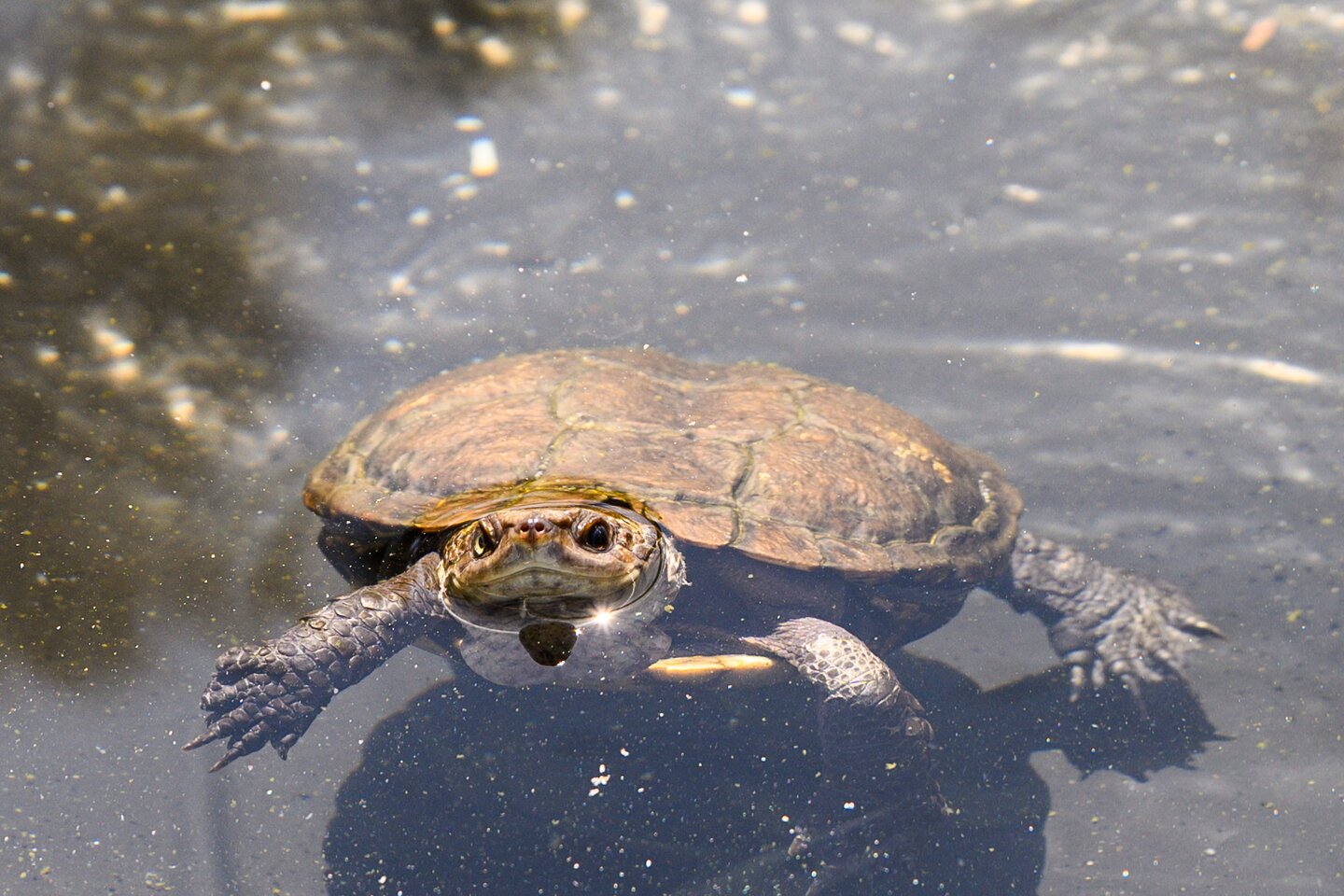Limitless: For more than a century, scientists believed the western swamp tortoise was extinct.

Perth Zoo is working to bring native animals back from the brink of extinction.
For more than a century scientists believed the western swamp tortoise was extinct.
All that changed in the early 1950s when a young man discovered a small tortoise in the Swan Valley. Today, the species is said to be Australia’s rarest reptile.
The tortoises have survived in the wild in just two locations north of Perth, with experts working to build populations in two further habitats to improve the survivability of the species.
The odds have been stacked against them.
Reduced rainfall, climate change, and the expansion of urban developments have been among the biggest threats to the tortoises.
Predators such as foxes, and susceptibility to wildfire while aestivating (similar to hibernating) under leaf litter in summer, have brought additional barriers to rehabilitation of the species.
That’s why as recently as 2003, the federal environment department said as few as 200 tortoises could be left in the wild.

The tortoise enclosure at the zoo. Photo: David Henry
“We don’t have many wetlands on the Swan coastal plain, the only conventional populations that persist are up around Bullsbrook,” Perth Zoo science program leader Harriet Mills told Business News.
“With all the agriculture and urban development around those natural populations, they’re under quite a bit of pressure.
“The watertable is dropping … put climate change on top of that and the long-term sustainability of those populations is under a bit of doubt.”
Declining rainfall has put the population under severe stress, Ms Mills said, because the tortoises only eat and breed when their wetlands fill with water.
But behind the scenes at Perth Zoo, a team has been working to develop the tortoise’s population and keep the critically endangered species alive into the future.
The zoo has housed ‘swampies’, as the keepers call them, for nearly 60 years, and has been breeding the reptiles since the 1980s.
It was one of Australia’s first native species breeding programs.
More than 1,000 swampies have been reared and released into the wild since 1989, with the latest group of 191 tortoises settling into the environment in September.
“We’ve really increased the security of the population,” Ms Mills said.
“They’re still classified as critically endangered.
“But they are on the path to recovery.
“Just the fact we know we can breed them in captivity if we need to is quite reassuring.”
Scientists selected Moore River, about 120 kilometres north of Perth, and Scott National Park in the South West as new homes for the tortoises; part of a plan to create new habitats for the species.
Developing populations in more locations will help the species become more resilient to potential risks, including a changing climate.
Nature reserves have been expanded gradually to create more habitat, in line with the state’s recovery plan for the tortoises.
Midland Brick sold space to grow one reserve in 2006 as part of a land swap deal to mine in another location, while also contributing material to construct the zoo’s breeding facility in 2014.
Redemption
Repopulating the species starts with the team at the zoo.
When Business News goes behind the scenes at the native species enclosure to see the program up close, senior zookeeper Karen Cavanough is cutting up snacks for the tortoises.
The minced mix of mosquito larvae, crustaceans and black worm is referred to as ‘swampie pudding’.
“I’ve always loved wildlife and conservation,” Ms Cavanough told Business News.
“We’ve all been studying and trying to get into the zoo for many years, this is where we want to be.
“This section … awesome species to work with, actually making a difference.
“Helping breed them and release them ultimately back into the wild is what the zoo’s all about really.”
At the facility, just as in the wild, tortoises start digging nests and laying eggs in late October.
The keepers incubate the eggs in special equipment to maintain warmth, a precise game because temperature may impact the gender balance of hatchlings.

A small tortoise. Photo: David Henry
Baby tortoises hatch at a length of less than three centimetres, and usually weigh less than seven grams.
Adult tortoises grow to be up to 550 grams, with shells 15.5 centimetres in length.
The tortoises are moved to more spacious ponds as they gain size, and for the summer they are given a home with leaf litter to burrow into.
They’re inactive from December until April or May, not eating, and their metabolism slows while they are in aestivation.
Reflecting on a recent release day in August, the keepers had mixed emotions.
“We’re very happy to have them boost the populations,” Ms Cavanough said.
“Release days are the best days.
“It’s always sad to see them go, but a great outcome.”
The zoo has partnered with the University of Western Australia to radio track the tortoises after release into the wild.
For Ms Cavanough, supporting the recovery of the tortoise is a second career, having left a role in the public sector as an IT manager.
“I wanted to do something I love,” Ms Cavanough said.

The dibbler is a shy, native marsupial. Photo: David Henry
A difference
Science program leader Ms Mills said some of the zoo’s older swampies were captured in 1958.
“We think they live at least 80 years, quite possibly 100 years, maybe longer,” she said.
“For such a little animal it’s amazing to think.”
Ms Mills said her role in the zoo was a privilege.
“Not many people get to come to work and see a numbat or a dibbler or a western swamp tortoise or a white bellied frog,” she said.
“These are endangered or critically endangered species.
“People care about them, but not many people get to see them close up.
“To be able to see them, but also know you’re making a difference, is what brings me here.”
Ms Mills has come full circle in her career.
She studied her doctorate on dibblers, a marsupial under rehabilitation at the zoo, and then worked at UWA and Edith Cowan University.
The zoo was a good place for researching endangered native species, Ms Mills said, as they could be intensively monitored, and populations had decent sample sizes.
Not every zoo could genuinely say it contributed to conservation by breeding animals for release into the wild, she said.
“This is exactly what we do,” Ms Mills said.

Harriet Mills with the dibblers. Photo: David Henry
Dibblers
The dibbler is a small marsupial that resembles a mouse and is most active at sunset and sunrise.
But it has character, the zoo team says.
On their diet of predominantly insects and meat, dibblers grow to be up to 125 grams in weight (lighter than a cricket ball).
Much like the swamp tortoise, the dibbler had been thought extinct for decades until a chance discovery on a beach near Albany, in 1967.
The little mammals were also found on two islands off WA’s coast, and programs are under way to create new habitats.
Breeding dibblers at the zoo started in 1997, making 2022 the 25th anniversary.
It’s a challenging operation, as the marsupials are only receptive to breeding for a few days in a year.
The animals also eat their young when stressed.
After life in the zoo, both the western swamp tortoise and dibbler are protected by the Parks and Wildlife Service through programs like Western Shield and Return to 1616.
Return to 1616 targets Dirk Hartog Island, where the government has sought to remove sheep, goats and other invasive animals to restore the island to its initial ecological state.
Western Shield also hopes to protect endangered species from introduced predators and was granted a $1 million funding boost by Alcoa.
Ms Mills said recovering endangered animal populations was achievable, although it required investment.
“We came very close to losing western swamp tortoises, and dibblers as well,” she said.
“But the good news is we can recover these populations if we manage them carefully.”













